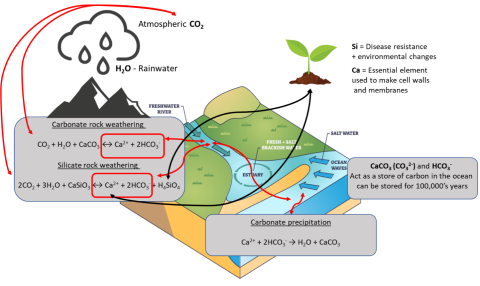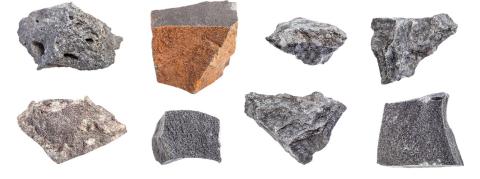27th of September 2022
Dr David Cutress: IBERS, Aberystwyth University.
- Silicate and carbonate reactions could offer a route for long-term carbon storage
- Whilst issues surround carbonate minerals, silicates, like basalt rock, appear more promising
- Applying crushed silicates to agricultural soils could benefit carbon footprints, nutrient availability, pH, soil water retention and plant growth and yields
- Currently, there is very limited field-based evidence of the possible off-target long-term impacts of this strategy on global ecosystems
- More research is needed before further highlighting the environmental potential of silicate weathering and providing incentives to utilise such practices
Rock weathering and agriculture?
The current climate focus along with environmental warnings are making carbon capture and storage activities a higher focus than ever before. Whilst strategies such as increased tree planting, min/no-till, bioenergy crops and legume integration are well noted for their potential in reducing agriculture's carbon footprint there are some other less direct tools to consider. Rock weathering involves the ability of silicate and carbonate materials to remove carbon dioxide (CO2) from atmospheric cycles this acts as a natural control for climate change/global warming and has been known for a long time. It has relatively recently come to the forefront for its potential as a mitigation tool directly for agriculture's high emission profiles. Articles have noted the potential to include silicate-rich materials such as basalt into agricultural soils so that they can draw down extra CO2. An article in nature in 2020 highlighted the potential of this strategy and received a great deal of interest and further citations (over 150 within 2 years demonstrating a high level of attention).
This draw-down function is a part of the carbonate-silicate geochemical cycle or the ‘Inorganic carbon cycle’. This involves reactions between elements of rocks with atmospheric CO2 and water (H2O).
This diagram shows the route which could be used within agriculture towards carbon storage but it should be noted that this is a cycle (though a long-term cycle) and CO2 is eventually re-released (1000’s years). This re-release occurs via mechanisms such as the volcanic breakdown of calcium carbonate (CaCO3) and silicon dioxide (SiO2). Weathering processes are also under investigation for “artificial” weathering in reactors for carbon capture and utilisation strategies, though there appears as yet to be no commercially ready solution to achieve this efficiently.
What does this mean in practice?
Essentially this strategy would involve the application of fine silicate dust (such as basalt) onto agricultural lands similar to the process of applying lime. In arable studies, a suggested addition of 40 tonnes of basalt per hectare per year was used as it was shown to be within range for improving crop production in field trials. Whilst other trials have noted figures between 0.5 and 10kg of basalt per m2 (equivalent to 5 – 100 tonnes per hectare). The finer the particles the higher the surface area and CO2 removal from the atmosphere, however, it has been noted that there would need to be a balance between particle size and energy needed to produce finer powders. The process involves basic cations (positively charged particles) being released into the soil/water interface during mineral weathering meaning that this can also act as a tool to reduce soil acidification. Reducing soil acidification could allow silicates to act as a replacement liming material which like lime itself increases soil pH and reduces N2O emissions associated, this is powerful as N2O is roughly 270 times more detrimental than CO2. In systems where there are naturally occurring high quantities of silicate minerals (areas with high volcanic ash), it has been noted that, long-term soils are largely neutral or only minorly acidic and that these soils also show interesting potentials for organic carbon (C) storage over time.
Alongside CO2 benefits, silicate weathering also releases other plant nutrients into the soil, for example, basalt (the main rock considered across literature) includes Silica (Si), potassium (K), phosphorous (P) and calcium (Ca) that can be utilised by crops to improve vigour and yields giving added benefits. Equally, there is an association between this process and the reduction of nitrogen (N) present in runoff as well as reduced acidification of soils (reducing the need for lime addition in intensive systems). This has been understood since the late 1800s with silicon wastes used as fertiliser in US systems, though historically the CO2 reduction implications were not realised. One benefit to consider with this strategy is that there may already be pathways in place that would enable the large-scale application of silicates like basalt to croplands due to similarities to the current liming practices.
Whilst the increased need for mining silicates would be a consideration for supplying this resource globally, there is also the possibility of utilising waste resources such as slag from iron and steel manufacturing (2.7% already used for fertiliser nutrients in Europe), demolition waste, cement wastes and by-product silicates from other current mining endeavours.
What CO2 reduction is suggested?
CO2 uptake via this system is influenced by temperature, level of runoff and the available surface area of the rock/mineral in question. Temperature is a key factor with weathering being more efficient at higher temperatures. In natural systems, weathering acts as a partial natural buffer to global warming (as global temperatures rise, more weathering draws down more carbon from the atmosphere). What this means in practice is that countries with higher average temperatures will see increased benefits to the inclusion of weatherable rocks onto landscapes (as long as they have the high precipitation levels to go along with this). This was noted in one model where Indonesia and Brazil showed high carbon dioxide removal potential due to a combination of their extensive available agricultural land (on which to apply the minerals/rocks for weathering) and their warm/wet climates which are conducive to weathering efficiency. Whilst this might suggest that the temperate climate of the UK might not be the best for this system of CO2 removal a follow-up Nature paper, in 2022, noted that employing this strategy across UK croplands could remove 6 – 30 million tonnes of CO2 a year representing 45% of the C removal required to hit net zero-emissions by 2050. If this modelling proves correct this offers a substantial opportunity for agriculture as a sector which is already known to be vital for its potential role in carbon sequestration. Other studies have suggested reductions of 2.5 Gigatonnes (Gt) of CO2 a year (1 gigatonne = 1 billion tonnes) over 50 years following a single one-off application of basalt dust (In this specific instance assuming the land was not disturbed for arable use). In studies of application on cropland it was noted that applying basalt to around 10% of croplands at 0.039 – 0.84 Gt a year should lead to 0.5 Gt CO2 reductions. Whilst silicate application values can be enlarged to increase the CO2 reductions achieved it has been noted that thresholds exist where higher basalt dust addition had far less impact on CO2 reducing the efficiency of its application.
Of course, the processing and transport of silicate minerals have CO2 emissions associated as well as costs. Whilst the emissions have been calculated in many of the models (though production in different countries has different impacts depending on their main source and efficiency of energy production) these along with the costs would need consideration to make this strategy appealing and feasible overall. It is suggested that the direct valuation of C is a current question throughout agriculture concerning the value farmers can see from their climate mitigation actions. The World Bank forecasts $100 – 150 per tonne of CO2 by 2050. Comparing this to the costs predicted from the 2020 nature paper which found the cost of silicate application to range from $54.3 - $220.3 per tonne CO2 extracted per year depending on country and intensity of applications. This suggests that even in the most expensive scenarios CO2 capture value would mitigate between 1/3 and 2/3rds of the costs incurred. The costs of rock weathering are therefore equivalent to other strategies being considered from bioenergy with carbon capture and storage (BECCS) strategies being explored such as biochar and direct air capture and storage.
The use of basalt for weathering as noted also provides a source of P and K for the soil with P being noted as an essential nutrient which limits biomass production globally thus adding a co-benefit to basalt dust addition. Increasing biomass production by alleviating P constraints concurrently means more CO2 will be taken from the atmosphere and stored in plant biomass. This suggests an even higher potential for basalt dust in tropical (warm/wet regions) with depleted P levels in soils. Alongside CO2 reductions, this process should play a role in increasing the alkalinity of oceans with a beneficial impact on the growth of corals and diatoms (key in removing CO2 via photosynthesis and providing nutrients in ocean food chains) thus likely a positive impact on biodiversity. Also increasing the alkalinity of oceans makes them able to store more C providing positive feedback on C sequestration overall.
What are the uncertainties?
As noted in the inorganic carbon diagram the reactions for carbonates and silicates are reversible. There is the suggestion that this action could mean that soil chemistry in certain conditions leads to the promotion of carbonate minerals which acts as a store of C rather than HCO3- and CO32- making their way to the ocean for storage. Whilst this function in itself has been investigated for its potential as a carbon sink it was noted in one paper that this action is only half as efficient in sequestering CO2. The other issue with considering carbonate minerals, rather than silicate, is that in acidic agricultural soils (which are more common in intensive systems) it can lead to negative CO2 fluxes out into the atmosphere increasing carbon footprints, making silicate weathering more promising. Equally important is the understanding that reactions can occur to slow and inhibit this carbon storage aspect in field conditions, which have not been expansively enough researched. For example, the cations produced by weathering could bind to ion exchange surfaces or react to form other secondary minerals and never reach the ocean where the major sequestration benefits are suggested to occur.
What is also a worry are the impacts on eutrophication of aquatic systems, biosphere-atmosphere feedback, biodiversity and air, water and soil pollution impacts of long-term silicate dust applications as this is currently under-researched. Such aspects could play a significant role in the functionality of ecosystems so would need further study. Also, as with many particles of small size the finer the basalt dust used (<10 μm) the more impact it will pose to human/animal health via wind transport and inhalation. This would likely be an issue in management scenarios with increased soil erosion such as high tillage (and other physical soil disturbances like heavy machinery use) and strategies which allowed the presence of repeated bare soil and a lack of substantial root/plant coverage year-round to aggregate soils, which in themselves also have negative impacts environmentally relating to emission profiles.
Whilst basalt is the main silicate mineral considered within this article and many research publications, silicate strategies would likely work most efficiently by utilising nearby locally sourced minerals. Equally, to achieve a suggested 2 mm coverage require 40 tonnes per hectare so to employ across all UK cropland would require >240 million tonnes of silicates. This means a range of silicate minerals would need to come into consideration with different geochemical compositions which could lead to the release of different trace metals and other compounds into environments which may have different positive and negative effects that need researching. For example, it was noted that antimony and selenium leaching from demolition and construction wastes could lead to concentrations in the environment above the acceptable range for water quality standards. Such by-products and leachates would also have considerations on uptake via crops from soils and food safety which would need to be assessed further.
Summary
Silicate application onto both agricultural landscapes and other conservation/rewilded landscapes and forestry theoretically appears to have a lot of potential as a carbon capture tool. Silicates have suggested benefits to systems which incorporate plants (forests, arable and pastoral) as co-products released during the weathering process should improve plant growth and yields. Despite suggested benefits, there are many unknowns due to a lack of field-level experimentation with such strategies. As such efforts should be made to research potential off-target ecosystem implications before considering advising and incentivising landowners towards incorporating such strategies into their management considerations. Despite this, use of silica-based fertilisers in the US (and to a small extent in Europe) and equivalent issues of utilising lime applications on soil may be enough to make silicate application an alternative and alluring strategy.
If you would like a PDF version of the article, please contact
heledd.george@menterabusnes.co.uk



